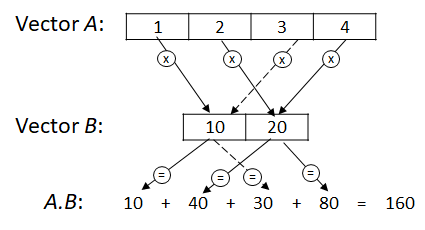We are interested to perform the dot product for unequal-length vectors.
Algebraically, the dot product is the sum of the products of the corresponding entries of the two sequences of numbers.
The dot product of two unequal-length vectors $A = [a_0, a_1, \cdots, a_{N-1}]$ and $B = [b_0, b_1, \cdots, b_{M-1}]$, where $N>0$, $0<M<N$ and $N = k\times M, k \in \mathbb{N}-\{0\}$, is defined as: $A \cdot B = a_0b_0 + \cdots + a_kb_{M-1} + a_{k+1}b_0 + \cdots + a_{N-1}b_{M-1}$.

Running examples

- Write the function $\texttt{int READDIM_A()}$ that reads and returns a strictly positive integer $N$ less than 50;
- Write the function $\texttt{int READDIM_B(int N)}$ that reads and returns a strictly positive integer $M$ divisible by $N$;
- Write the function $\texttt{void READARRAY(int Arr[], int C)}$ that reads $\texttt{C}$ positive integers of the array $\texttt{Arr}$;
- Write the function $\texttt{int DOTPRODUCT(int A[], int N, int B[], int M)}$ that returns the dot product of two unequal-length arrays;
- Using all the above written functions, write a $\texttt{main}$ function that reads two unequal-length arrays and then displays their dot product.
Difficulty level

This exercise is mostly suitable for students
#include<stdio.h>
#define size 50
int READDIM_A()
{
int N;
do {
printf("Enter dimension: ");
scanf("%d", &N);
} while (N <= 0 || N>size);
return N;
}
int READDIM_B(int N)
{
int M;
do {
printf("Enter dimension: ");
scanf("%d", &M);
} while (M <= 0 || M > N || N % M);
return M;
}
void READARRAY(int Arr[], int C)
{
int i;
printf("Enter %d elements: ", C);
for (i = 0; i < C; i++)
scanf("%d", &Arr[i]);
}
int DOTPRODUCT(int A[], int N, int B[], int M)
{
int i, j, sum = 0;
for (i = 0, j = 0; i < N; i++, j++)
sum += A[i] * B[j%M];
return sum;
}
int main()
{
int A[size], B[size];
int N, M;
printf("Array A:\n");
N = READDIM_A();
READARRAY(A, N);
printf("Array B:\n");
M = READDIM_B(N);
READARRAY(B, M);
printf("Dot product = %d\n", DOTPRODUCT(A,N,B,M));
return 0;
}Back to the list of exercises
Looking for a more challenging exercise, try this one !!
 Adding very large integers numbers
Adding very large integers numbers